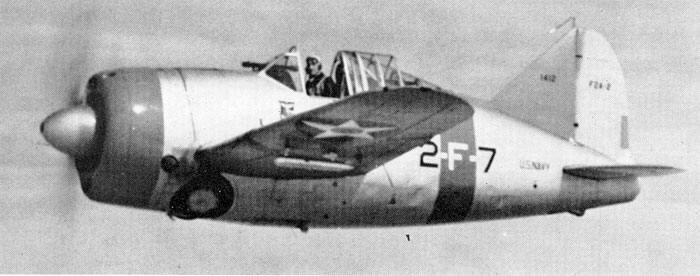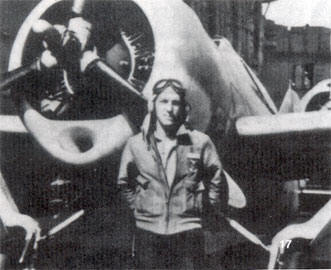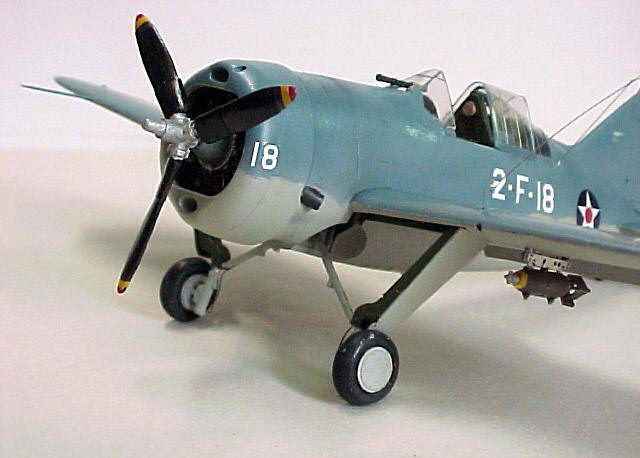|
The Fighting Chiefs and the
F2A
USS Lexington Brewsters
by Joe Lyons


HyperScale is proudly supported by Squadron
The Aircraft
Fighting Two (VF-2) was a
unique USN Squadron in the early 1940s. Most of its members were
non-commissioned officers (hence the Squadron’s insignia) and, it would be the
only CV Squadron to operate the Brewster F2A after the US entered the war. This
article looks at the two versions of this airplane used during the period 1940
into January 1941, the F2A-2 and the F2A-3. Home for the Brewsters at sea of
course was USS Lexington (CV-2).
[To my knowledge these aircraft were not known as
“Buffalos” in USN service, at least during the period addressed, so the name
will not be used herein]
The chequered development and career of the F2A is well
covered in many sources. Suffice it to say that it was the navy’s first
monoplane fighter, saw little combat with that service and was replaced by the
F4F immediately after the war began in the Pacific.
Brewster F2A-2 (BuNo 1416) [VF-2, “2-F-11”]
This particular ‘Buff version was as close as the west came
to building a Zero:
|
Aircraft |
Fuel |
Armament |
HP |
Loaded Weight |
Wing Area- ft2 |
lb/hp |
Wing Loading-lb/ ft2 |
|
Zero Type 21 |
120 Imp Gal |
2-20mm2-7.7mm |
940 |
5313 lb |
247 |
5.65 |
21.5 |
|
F2A-2 |
200 gal |
4-.50 cal |
1200 |
5913 lb |
206 |
4.95 |
28.7 |
Neither had any sort of passive protection. USN sources
generally consider the –2 to be the best of the Brewster fighters (Boyington
said it could “turn inside a phone booth”). By contrast the export version
traded performance for passive protection, as did the navy –3. BuNo 1516 was
built in VF-2 markings and got to VF-2 in October 1940, remaining with the
Squadron until replaced by the F2A-3 in September 1941. Note the 200 gal of fuel
inside a 6000 lb loaded airframe. This was 70 gal more than the P-40 and over
twice as much as carried by Spitfire, Hurricane and Bf-109 contemporaries. It
was overhauled in December 1941, served briefly with VMF-111 and 121 and was
stricken in October 1942 at NAS Miami. While with VF-2 its Brewster ancestor,
the F2A-1 dressed in Finnish markings, was on the way to setting several
unmatched WW II fighter records. Mustang, Spitfire and Dora aficionados?
Eat your hearts out.
29 different F2A-2s were assigned to VF –2 at one time or
another. I can find only one photo of a Golden Wings VF-2 F2A-2 (BuNo 1412),
other than what is factory publicity shot possibly of 2-F-1. There is one other
photo of an ex-VF-2 bird in July 1942. This photo shows BuNo 1412. Note the
target “can” on the port bomb rack.
F2A-3 BuNo 1549 (2-F-18)
Painted Blue-Gray over Light Gray.
 The entire air group
would be so painted until such time as the December 23 directive on rudder
stripes was implemented. I have found two photos of VF-2 ‘Buffs in Blue-Gray
where the Squadron markings are visible; neither is cross-referenced to a Bureau
Number. But Thomas Doll’s new book on navy markings has a color drawing of
2-F-18 and a photo that shows AP 1/C Howard S. Packard standing in front of it
(perhaps). The entire air group
would be so painted until such time as the December 23 directive on rudder
stripes was implemented. I have found two photos of VF-2 ‘Buffs in Blue-Gray
where the Squadron markings are visible; neither is cross-referenced to a Bureau
Number. But Thomas Doll’s new book on navy markings has a color drawing of
2-F-18 and a photo that shows AP 1/C Howard S. Packard standing in front of it
(perhaps).
The –3 Brewster will add more fuel, and armor, but no more
horsepower. Like all its contemporaries designed on the cusp of the war it has
the wing lumps and bumps to accommodate weapons for which they were not
intended. Performance will suffer compared to earlier versions, but navy pilots
in a position to evaluate both types saw little difference between this F2A and
its F4F peer. VF-2 will be the only navy Squadron to fire the guns of this
airplane in anger.
The conventional wisdom of the F2A/Buffalo is that it was a failure as a
fighter, except in the hands of the Finns. However, I believe a case can be made
that the USN would have been better off in the great 1942 carrier battles with
the F2A rather than the F4F. How dare I say this? More gas for one thing: 200+
gal vs. 130. The Wildcat’s range limitations are very manifest in the accounts
of those days. And, perhaps a faster rate of climb depending on which source you
believe. No match for the Zero on the Zero’s terms to be sure, but neither was
the F4F.
F2A-2
The Tamiya kit is currently the only game in town in 1/48 scale. It is built
almost straight from the box, except for some True Detail photo-etched parts.
Given the closed canopy, I really shouldn’t have bothered with the P/E. Eduard
provides a delightful D/F antenna to wrap around the life raft; regrettably
neither the kit nor the Falcon canopy can be installed with it in place, so it’s
not.

As with all VF-2 Brewsters, BuNo 1516 does not have the antenna mast, the aerial
being led instead to a stub on the port wing.
F2A-3 BuNo 1549 (2-F-18).
This is the Tamiya F2A-2 kit modified to be a –3.
The
principal change is the 10” fuselage extension forward of the vents on a line
with the antenna mast. This is a straightforward job. After assembly of the
completed fuselage, the cowl is detached from the nose with a razor saw. 10 thou
plastic sheet extensions were glued into the fuselage to provide support for 20
thou plastic sheet representing the nose extension. The whole lot was faired in
with putty. There is a small bit of panel line scribing necessary to make the
extension blend with the fuselage proper, and then the cowling is reattached. Eduard open split flaps. An open Falcon canopy justifies the Eduard P/E set,
mostly of the cockpit. When combined with some kit parts the cockpit is a good
copy of the photos the F2A prototype cockpit. This set caters for all the
pre-F2A-3 aircraft, USN and export. I’m presuming it is adequate for the –3 as
well. I used a Curtiss cuffed prop from the spares box, left over I think from
an abortive KMC Wildcat conversion.

A Monogram B-17 Cyclone replaces the kit engine which, while good, like all of its
modeling brothers is molded smaller than scale to fit the kit cowl. Judicious
cutting away of the B-17 engine in areas not visible when closed up made its use
possible.
The only other substantial visual points on VS-2 F2A-3s are the frameless
sliding canopy and the rerouting of the radio antenna much as was done with VS-2
F2A-2s. While there are no metal frames on the canopy, the butt joints of the
Plexiglas sections are not invisible. I added Accurate Miniature 100 lbs and
racks leftover from the F3F-2 kit.
F2A-2
The “Golden Wing” era had its own rules, many of which have
puzzled modelers for years. Fortunately, there was very little artistic license
allowed among aviation activities required to conform to directives, and we have
a good deal of photographic documentation.
By directive, the golden wings officially disappeared on December 31, 1940 but
as anyone who has watched “Dive Bomber” knows it took some months to fully
implement the replacement scheme. Thus in January 1941 for all the aircraft
addressed, the exterior coloration was:
Aluminum-pigmented lacquer overall, except the tops of the wings. Floquil Old
Silver used on all the metal surfaces. The 1937 reorganization of Squadrons had,
inter alia, standardized color markings for each carrier, such color being
applied to all the tail surfaces. Lexington’s color was Lemon Yellow, a
paler shade than Orange-Yellow. Testors Model Master Blue Angel Yellow was used
for this color. Kit decals were used, with the various kit numbers “juggled”
about to provide the correct BuNo and section numbers for this particular
aircraft.
F2A-3
The Blue-Gray for upper surfaces
officially implemented in November 1941 but done unofficially a few weeks before
in parts of the Pacific naval air force. National insignia remains the blue
star on a white circle with the red center dot. Testor’s MM Blue Gray and Light
Gray. White Markings and numerals from aftermarket sheets. I had finished this
model when I got the Aircraft Films F4F Wildcat DVD set containing the film
clips mentioned above. As I watched, it seemed as if the F2As viewed head-on “in
the groove” were overall light gray, but as they trapped or executed wave-offs,
it was obvious they were in Blue-Gray/Light Gray. A careful look at two still
close-ups of the time seem to show the Light Gray coming up around the entire
cowl ring causing the head-on overall gray look. So, I repainted the model
thusly.

In the Great Panel Line Shading debate, I subscribe to the
theory that if the panel was not openable on purpose, it does not get shaded. I
usually do this with black or gray pastel chalk on top of the base color. I have
no clue as to how do successfully any of the more glamorous techniques
a.
Brewster’s Benighted Buffalo. AIR Enthusiast Quarterly Number One.
b.
Doll, T.E. (1967). U.S.Navy Markings W.W. II-Pacific Theater. Sun
Valley CA: John W. Caler.
c.
Doll, T.E. (2003). US Navy Aircraft Camouflage & Markings 1940-1945
Carrollton TX: Squadron/Signal Publications
d.
Mass, J ((1987). F2A Buffalo in action. Carrollton, Tx: Squadron/Signal Publications
e.
Shores, C.F. (1970). The Brewster Buffalo Profile 217. Windsor,
Berkshire, England: Profile Publications Ltd.
f.
http://www.danford.net/buff.htm
All photos USN or the author
Click the thumbnails below to view
the images full-sized.
Use your browser's Back Arrow to return to this page:
Text Copyright © 2004 by
Joe Lyons
Images by USN or Joe Lyons
Page Created 01 January, 2005
Last Updated
01 January, 2005
Back to Reference Library
|
Home
| What's New |
Features |
Gallery |
Reviews |
Reference |
Forum |
Search